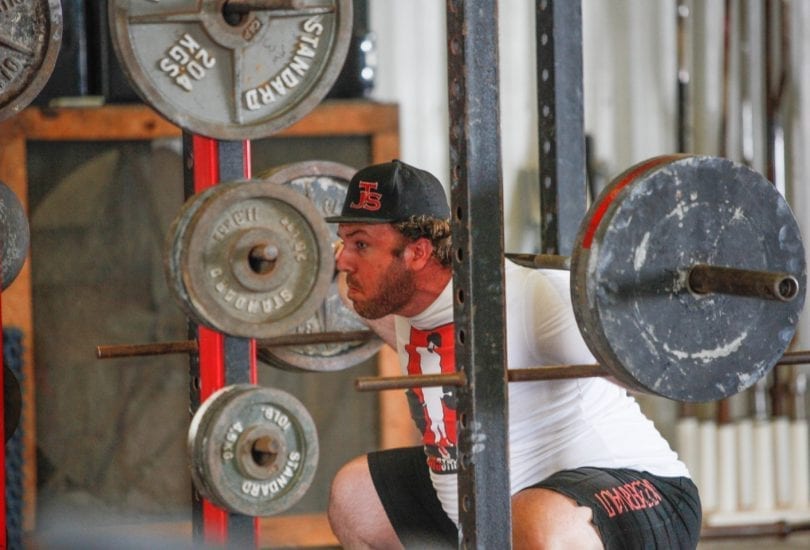Written by Molly Galbraith
In part 1 of this article, I gave a very brief introduction to energy systems, and discussed why I believe it’s important for powerlifters, strongman competitors, football players, and other strength/power athletes to incorporate aerobic work into their training program.
As I also discussed in Part 1, when people hear the word “aerobic” they immediately think of steady state jogging or running. While steady state jogging or running is often used to train the aerobic energy system, there are other much better options.
Here are a few:
Cardiac Output Work
This is about as simple as you can get. Pick an activity, or several activities, and do them for 20-60 minutes while keeping your heart rate in the 120-150 bpm range. Again, this is where many people would assume jogging is best. While I am not completely against jogging, there are better options, especially for strength/power athletes who already place a lot of stress on their joints.
A) Dynamic Warm-Up/Mobility Circuit
One of my favorite things to do for cardiac output is a solid dynamic warm-up or mobility circuit. Most of us slack on our warm-up and mobility work in the first place, so doing this kills two birds with one stone. You’ll get the benefit of the mobility work you should be doing anyway, and get your cardiac output work done at the same time.
Here is a video of one of my favorite circuits. You can repeat it as many times as necessary until you have completed your allotted cardiac output recommendation.
B) Sled Training Circuit
Here is another one of my favorite cardiac output methods. Combining light strength training movements with sled dragging is fantastic, low-impact, and very beneficial for recovery.
1) Backward sled drag for 20 seconds at brisk walking pace with light to moderate weight
2) 20 seconds of pushups at moderate pace with hands elevated if needed
3) Forward sled drag for 20 seconds at brisk walking pace with light to moderate weight
4) 20 seconds of planks, off the knees or toes, or lightly weighted if applicable
5) Backward sled drag for 20 seconds at brisk walking pace with light to moderate weight
6) 20 seconds of inverted rows at moderate pace and adjust body angle as needed
7) Forward sled drag for 20 seconds at brisk walking pace with light to moderate weight
8) 20 seconds of side planks, off the knees or toes, or lightly weighted if applicable
Walk for 1-3 minutes. Repeat Circuit for 3-5 rounds. Add 5-10 seconds per drill each week, up to 1 min each.
Tempo Work
Tempo work is another great method of aerobic energy systems training. It’s essentially low intensity interval training, or working at around 60-75% capacity, with active rest in between Below are two examples of the tempo work that Chad uses with his football players.
A) Bike Tempo Circuit
1) Ride Stationary Bike for 20-40 seconds at 60-75% of maximum output (probably between 100-120rpm)
2) Do 10 Pushups
3) Walk for 10-30 seconds, active rest period will need to be adjusted based upon fitness levels.
4) Ride Stationary Bike for 20-40 seconds at 60-75% of maximum output
5) Do 20-30 reps of bodyweight or lightly weighted abdominals
6) Walk for 10-30 seconds.
Repeat this cycle until you complete 6-10 rounds on the bike. Two to three series of this circuit is appropriate. The work intervals on the bike will need to be adjusted based upon fitness level. Remember, this is intended to be an aerobic-alactic drill, so your effort, work intervals and rest periods will need to be adjusted to reflect that for you and your athlete’s abilities.
B) Tempo Run Circuit
The following is an example of the ‘Big Circuit’ used by my college football athletes. “S” represents a “Short Rep” and “L” is a “Long Rep.” Distances are adjusted based upon positions.
Short is 60, 80 or 100yds for Linemen, Big Skill Players and Small Skill Players, respectively.
Long reps are 120, 160, and 200yds, respectively.
Rest periods between reps are walking the width of the field (50 yds) and rest periods between sets are walking the length of the field (100yds).
At the end of every rep, perform either 10 pushups or 20-30 reps of some type of abdominal work.
It is critical that every rep is performed in approximately the same pace and done with the same RPE (that should be 60-75% of maximum speed).
For example, if a small skill player’s best time for 100 yds is 10 seconds, he needs to be completing his 100yd tempo runs in 12.5-14 seconds at a 6 or 7 RPE.
RPE is significant here, because if his 1st rep is done at a 6.5 RPE and his 15th rep is done at a 9 RPE and both are completed in 13 seconds, they are not addressing the same objective, as the first rep was an aerobic development tool and the 15th rep was a speed endurance tool.
Rest time between reps and sets needs to be adjusted to ensure this is happening. Tempo style circuits, whether they are running/biking/running in water/etc. should have the athlete feeling winded while executing them but refreshed shortly after their completion.
Set 1: S S S
Set 2: S L S S
Set 3: S L L S
Set 4: S S L S
Set 5: S S S

HICT (High Intensity Continuous Training)
I was first introduced to HICT by my Coach, Mike Robertson, when he started learning about and implementing Joel Jamieson’s work. HICT is a very interesting method of aerobic work and one that not many people are familiar with. So what is HICT? Exactly what it sounds like.
High. Intensity. Continuous. Training. Or a high intensity exercise performed every 2-3 seconds continuously over an extended period of time, usually 20 minutes. Because the movements you use for HICT are so intense, you’re recruiting fast twitch muscle fibers, but because you are doing repetitions so infrequently, you don’t fatigue. HICT is a great tool for increasing the oxidative capacity of those fast twitch muscle fibers.
In general, around 60 minutes of total volume is recommended, although less prepared athletes and/or those with a lower aerobic component to their sport would still benefit greatly from 20-40 minutes. If performing more than 20 minutes of HICT total, take a 5 minute break in between 20-minute bouts.
Two of my favorite methods of HICT are as follows:
A) Weighted Step-Ups
I typically wear a 20-40 lb. weight vest and hold 10-15 lb. DB’s in each hand. As you can imagine, the weight vest is imperative because my grip would easily give out before 20 minutes if I had to hold 35 lb. DB’s in each hand. I set up a box so that my thigh is around parallel to the floor or slightly higher, and set a metronome app on my phone (or stand in front of a clock) to ensure that I perform one rep every 2-3 seconds. You can use whatever method you’d like to ensure than you perform a repetition every 2-3 seconds. I typically switch legs every 15-30 seconds to avoid local fatigue.
B) Heavy Sled Drags
This is another great method I love using for HICT. You simply load up a sled very heavy and attach it to a belt (I’ve found that trying to drag it with my hands or wearing a harness is less comfortable that a belt.) And you take one step every 2-3 seconds for 20 minutes. You can drag it forwards, backwards, or sideways.
Heavy Prowler pushes can also be used here, although my hands/wrists would get sore quickly. Using an Airdyne or a spin bike on a very high resistance also works very well for many people.
Now that you’ve been introduced to several examples of aerobic development work, you’re probably wondering how to incorporate it into your training. Below are 2 sample weekly templates, one for a powerlifter and the other for a football player.
***Keep in mind that 20 minutes of aerobic work is recommended often, but that may need to be increased based on your level of general physical preparedness, and the aerobic demands of your sport.
Sample Weekly Templates
Example 1: Powerlifter
Monday AM – Upper Body Strength Training
Monday PM – 20 – 60 minutes of Aerobic Work (choose from any modality above)
Tuesday PM – Lower Body Strength Training
Wednesday AM – 20 – 60 minutes of Aerobic Work (choose from any modality above)
Thursday AM – Upper Body Strength Training
Thursday PM – 20 minutes of Aerobic Work (choose from any modality above)
Friday PM – Lower Body Strength Training
Saturday AM – 20 – 60 minutes of Aerobic Work (choose from any modality above)
Sunday – Off
A structure like this will improve your aerobic foundation, help promote recovery between intensive sessions, and improve body composition, assuming you’re following a sound nutrition program.
Example 2: Football Player
Below is a sample template that Chad uses to incorporate aerobic energy systems work into his programming for his football team during the off-season. A similar template could also be followed in-season with lower overall volume. See an example of Chad’s in-season football training here.
Monday – Linear Speed Work/Jumps/Lower Body Weights
Tuesday – Aerobic Work via Tempo Runs/MB Throws/Upper Body Weights
Wednesday – Change of Direction Work
Thursday – Aerobic Work via Bike or Pool Tempos. Pool Tempos are performed the same way as Bike Tempos, just with running in place in the shallow end of a pool instead of bike riding. Work in the pool will have a greater therapeutic effect than work on land. Mobility Cardiac Output work is also a great option here.
Friday – Linear Speed Work/Jumps/Lower Body Weights
Saturday – Aerobic Work via Tempo Runs/MB Throws/Upper Body Weights
Sunday – Off
There you have it. Several different methods of of aerobic development work, with templates for incorporating them into your training so that they enhance your recovery, and improve your overall performance.
To learn more about energy systems training, visit Joel Jamieson’s site here and check out his book, Ultimate MMA Conditioning.
Molly Galbraith is a rapidly rising young trainer who is quickly making a name for herself in the fitness industry. She is a strength coach and co-‐owner of J&M Strength and Conditioning, a rapidly expanding, private studio gym in Lexington, Kentucky that’s quickly becoming the go-‐to place for professional athletes and the general public alike. In less than 18 months, they have gone from renting space at a local gym, to opening their own 7,500 sq. foot facility. Molly is also co-founder of the wildly popular Girls Gone Strong group, a movement dedicated to changing the way women train. She has also been an expert contributor to magazines like Oxygen and Experience Life. No stranger to the gym herself, she has competed in both figure and powerlifting and boasts a 275 lb. squat, a 165 lb. bench press, and a 341 lb. deadlift. Website, Facebook, YouTube, Twitter, Her Butt’s Twitter



